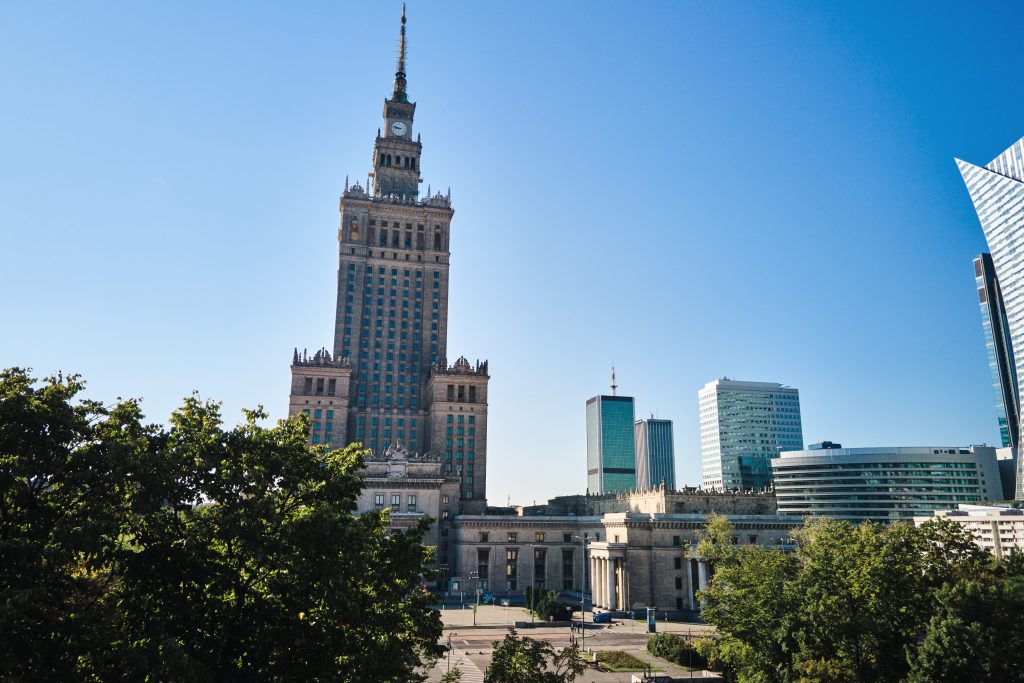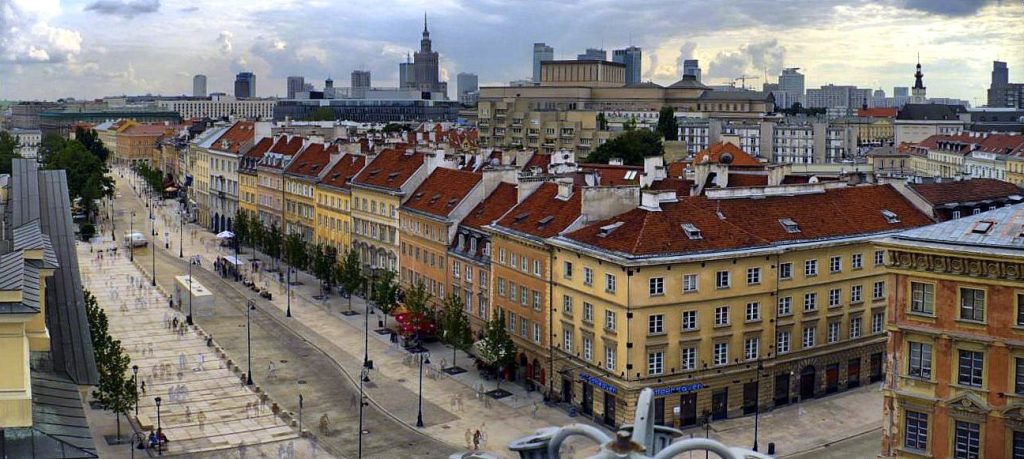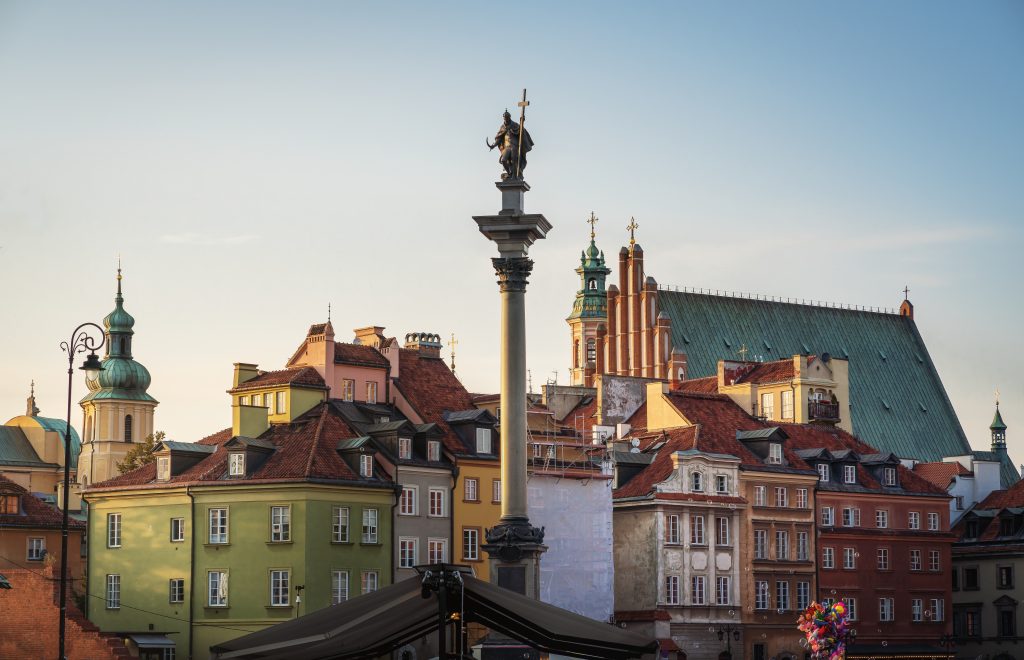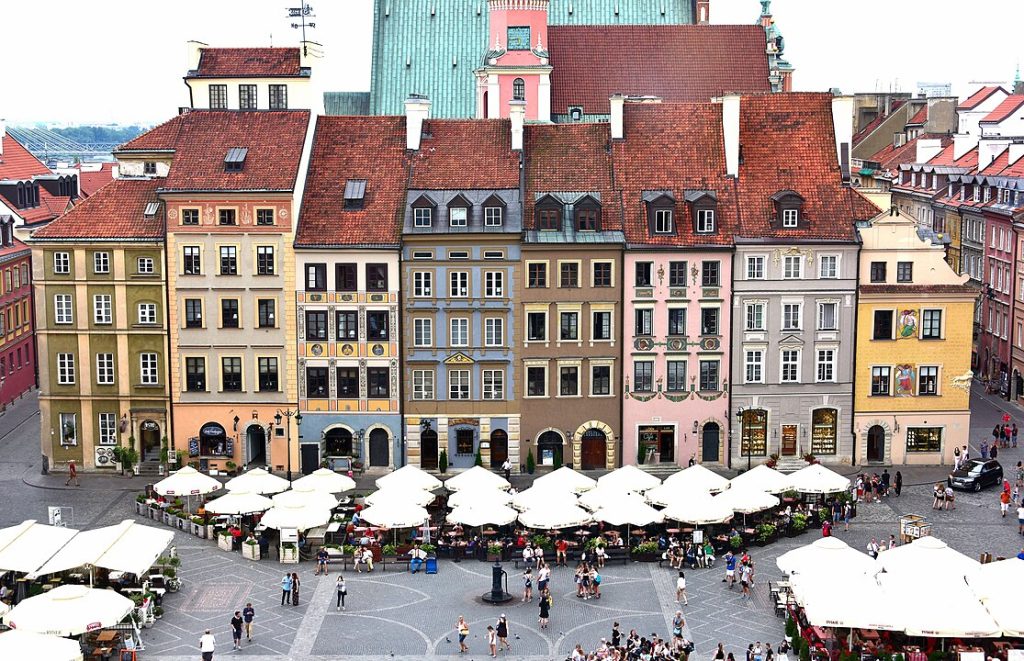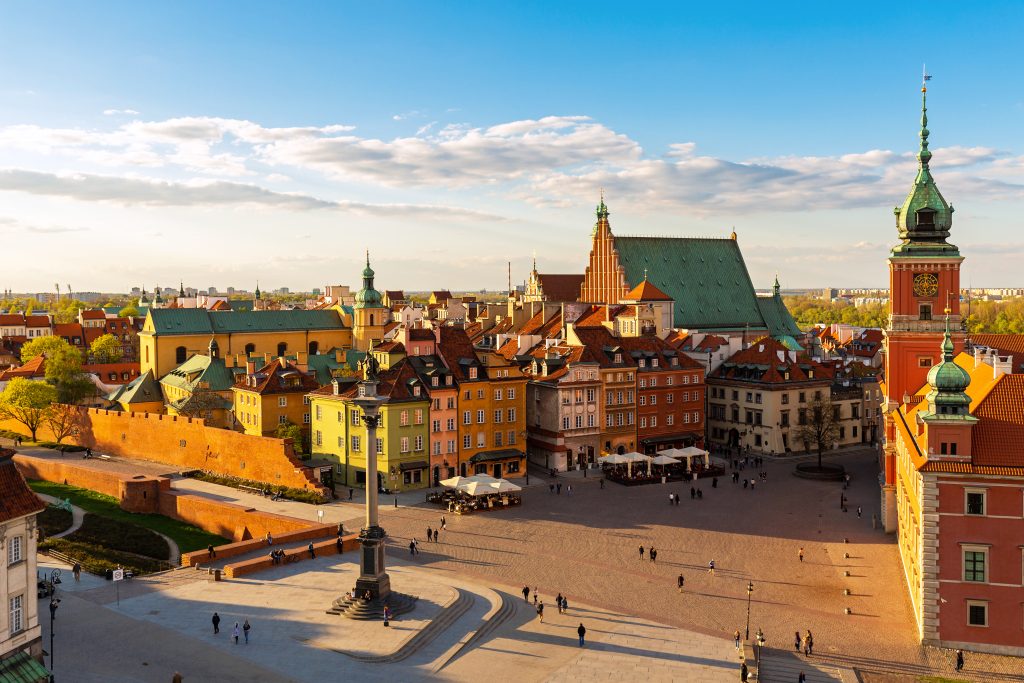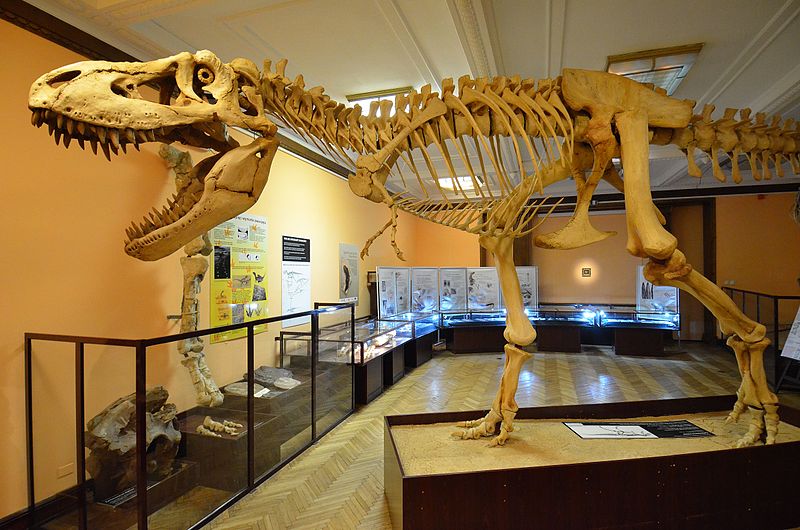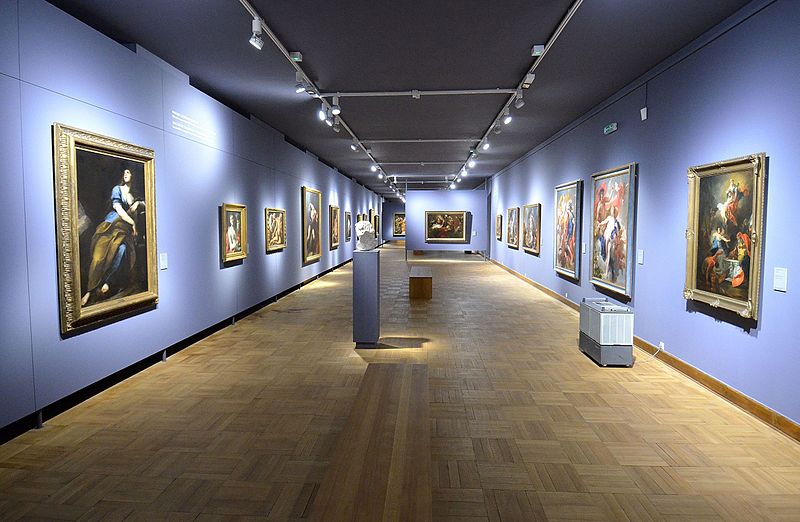- Introduction - why you should visit the National Museum in Warsaw
- "The Battle of Grunwald" - Jan Matejko
- "Stańczyk" - Jan Matejko
- "Babie lato" - Józef Chełmoński
- "Partridges" ("Partridges") - Józef Chełmoński
- "Jewess with oranges" - Alexander Gierymski
- "Portrait of a lady" - Anna Bilinska-Bohdanovichova
- "Death of Barbara Radziwillowna" - Joseph Simmler
- "View of Warsaw from the terrace of the Royal Castle". - Bernardo Bellotto (Canaletto)
- "Madonna with the Child, St. John the Baptist and an angel" - Sandro Botticelli
- "Battle of Orsha" - painter from the circle of Lukas Cranach the Elder
- "Strange Garden" - Jozef Mehoffer
- "Murzynka" - Anna Bilinska-Bohdanovichova
- "Guitarist" - Jean-Baptiste Greuze
- "Antibes - Morning" - Paul Signac
- "Seasons. July-August (Procession III - with a cow)" - Zofia Stryjeńska
- Completion - the greatest treasures of painting in one place
- 📍 Attractions in the area
- 🔗 Articles similar in subject matter
- 🔥 Most popular articles in the last week
- 💬 Opinions
Introduction - why you should visit the National Museum in Warsaw
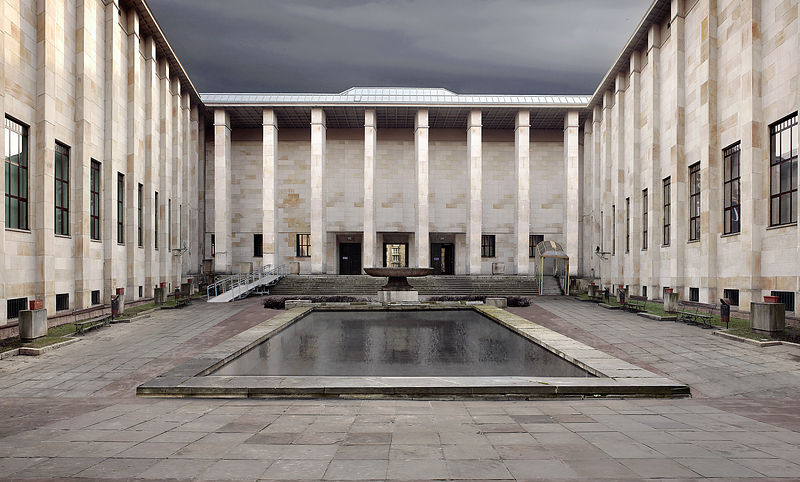
The National Museum in Warsaw is a veritable treasure trove of art, in which there is something for everyone. Its collections include more than 800 thousand works - From ancient monuments to medieval polyptychs to paintings by the greatest masters of Polish and European painting.
Already from the threshold you can feel that this place has in it unique atmosphere - a space where history meets beauty and art comes to life before the eyes of visitors. Here you can admire Masterpieces by Jan Matejko, Józef Chełmoński or Aleksander Gierymski, and alongside them delight in the works of world masters such as. Sandro Botticelli, Paul Signac or Jean-Baptiste Greuze.
A visit to the National Museum is not only a art history lesson, but also exciting experience - the opportunity to move back in time, to discover history enchanted in paint and canvas, and to feel pride in the richness of Polish culture.
"The Battle of Grunwald" - Jan Matejko
✔️ Official website of the painting
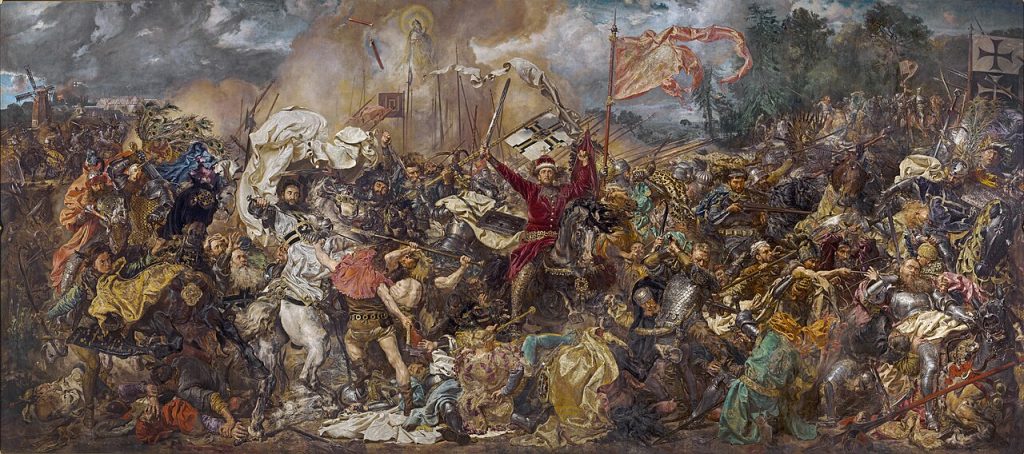
This is one of the of the most monumental works of Polish painting, painted by Jan Matejko in 1878. The huge canvas, measuring more than 4 meters high and 9 meters wide takes the viewer straight into the vortex of the battle that took place July 15, 1410.
Matejko captured the climactic moment of the clash between the Polish-Lithuanian army and the Teutonic Order - the dramatic scene of the death of Grand Master Ulrich von Jungingen. We can also see here King Władysław Jagiełło, standing proudly in the background, and Duke Vytautas, who is leading the charge.
The painting delights richness of detail - From the armor shining in the sun, to the expressive emotions on the warriors' faces, to the dynamic layout of the figures that makes the entire scene almost "come alive" before the visitor's eyes.
"The Battle of Grunwald" has become a a symbol of victory and strength of the nation, and one of the most important testimonies to the historical art of the 19th century. Today, it is a painting next to which no one passes by indifferently - and one of the greatest masterpieces to be seen at the National Museum in Warsaw.
"Stańczyk" - Jan Matejko
🌆 Want to see Warsaw from above?
👉 Viewpoints and terraces in Warsaw
✔️ Official website of the painting
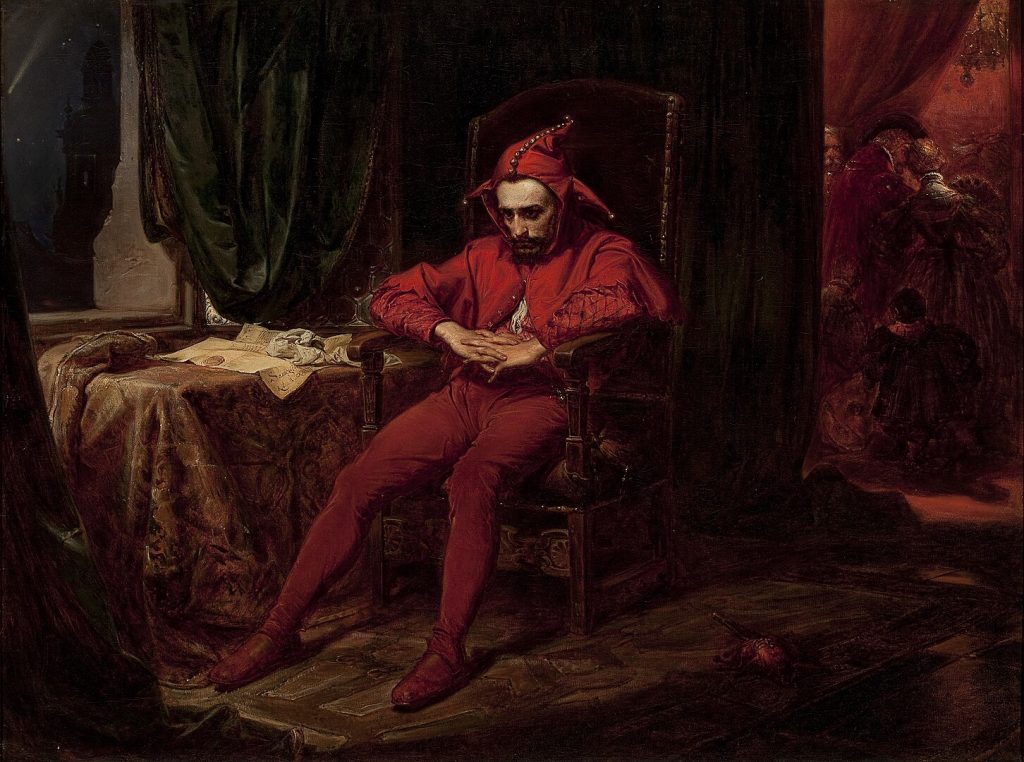
At first glance, we see a jester - a figure in a red outfit, sitting alone at a table. But "Stanchion" (1862) is much more than a simple portrait of a courtly treifnis. Jan Matejko created a painting that became a a symbol of Polish fate and national reflection.
In the background there is a lavish ball going on at Queen Bona's court, full of music and dancing. Meanwhile, Stańczyk - instead of enjoying himself - sits thoughtful and depressed. On the table lies a letter informing the the loss of Smolensk. This is the moment when the jester becomes the only truly conscious person among the partying elite.
Matejko gave his character deeply human emotions: fatigue, concern, awareness of the collapse of the state. Thanks to this, the painting gained enormous symbolic power. "Stańczyk" is not only a historical scene - it is a A universal story about the loneliness of a man who sees more than others.
Today this painting attracts crowds of viewers at the National Museum. In its gaze, everyone finds something different: a reflection on history, a reverie on the fate of the nation, or simply a poignant portrait of a man who laughs the last - and has the worst time.
"Babie lato" - Józef Chełmoński
✔️ Official website of the painting
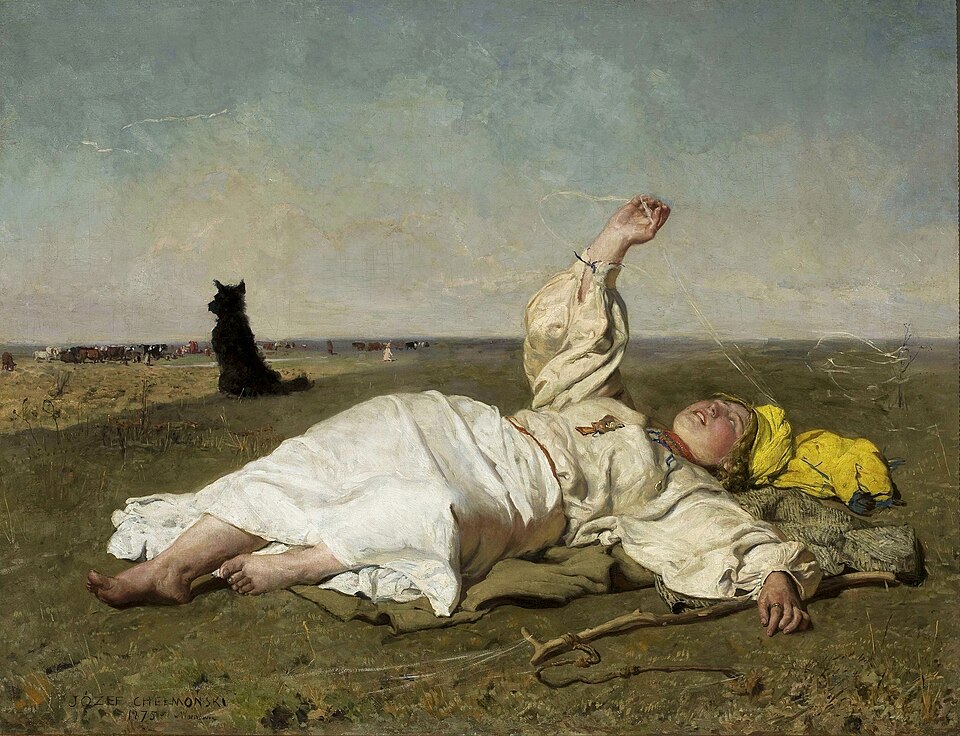
In this image from 1875 Joseph Chelmonski captured something extremely ephemeral - the poetic mood of an autumn morning in the Polish countryside. Against the backdrop of a vast landscape, we see a young girl in a white dress walking through a field, playing with a spider web floating in the air - the titular babe in summer.
The composition is deceptively simple, but it hides a profound symbolism. The girl, caught in a spider's web, seems suspended between the real world and a dream. This is a picture of transience and fragility of the moment, at this special time of year, when summer is slowly giving way to autumn.
Chelmonski was famous for his extraordinary ability to render the atmosphere of the Polish landscape. Here, nature becomes not just a background, but a a full-fledged hero of the work - Sunlit, slightly hazy, full of melancholy.
"Grandmother's Summer" is one of those paintings in front of which visitors to the National Museum stop for a longer time. The work captivates simplicity and poetry of everyday life, showing that true beauty is hidden in the most ordinary moments.
"Partridges" ("Partridges") - Józef Chełmoński
🧭 Discover Warsaw culturally and... for free
👉 Top 10 - free museums in Warsaw
✔️ Official website of the painting
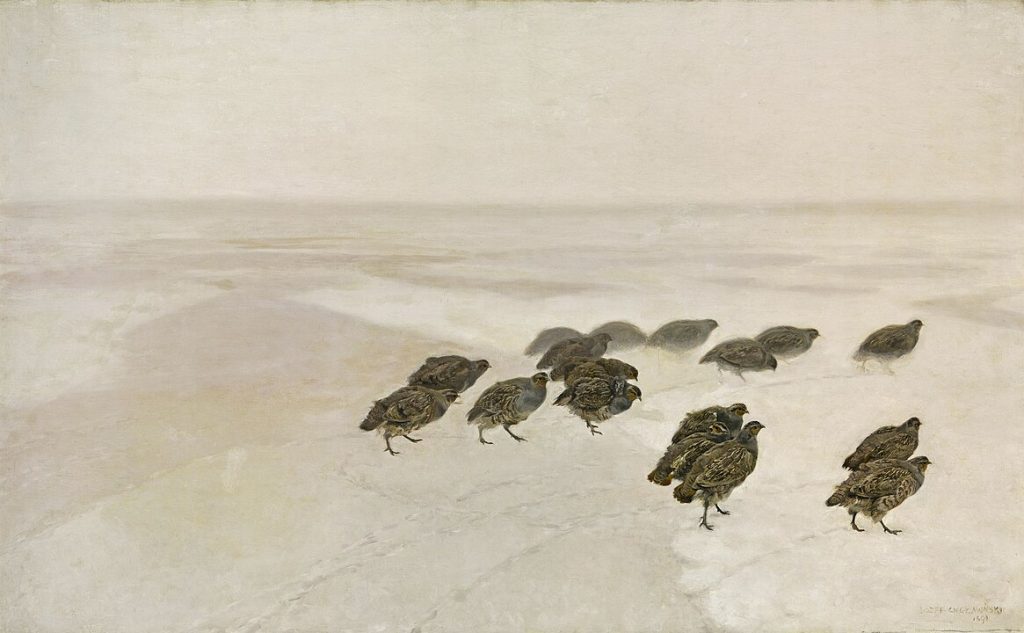
Jozef Chelmonski was a master at capturing Polish nature in its simplest yet most poignant form. The painting "Partridges" from 1891 is the best example of this. The canvas shows a small flock of birds huddled amidst a snowy winter void.
The composition is seemingly modest - it lacks people, movement or dramatic events. Yet Chelmonski was able to make this view extremely moving. Shrinking partridges They symbolize the fragility of life, and the boundless white around them captures the harshness and silence of the winter landscape.
The painting is full of realism: the artist has faithfully rendered the texture of the snow, the gray of the winter sky and the delicate shadows that create an atmosphere of coolness and tranquility. This work shows his extraordinary talent for combining a simple nature scene with a deep emotional charge.
"Partridges" has become one of Chelmonski's most prized paintings and is one of the true treasures of the National Museum in Warsaw. This is an example of how a small scene of nature can contain a A poetic tale of life, survival and the beauty of nature.
"Jewess with oranges" - Alexander Gierymski
✔️ Official website of the painting

This is one of Aleksander Gierymski's most moving works, painted around 1880. The painting depicts an elderly, tired woman with a basket full of oranges, standing against the backdrop of a Warsaw street. Her A hunchbacked figure, dimmed eyesight and poor clothing contrast with the vivid colors of the fruits she holds in her hands.
Gierymski was a master of realism and was able to render with extraordinary sensitivity the truth of everyday life. He did not idealize his heroine - he showed her as she was: tired of fate, full of dignity, and at the same time marked by the hardships of existence.
"Jewish woman with oranges" is not only a painting, but also a social commentary. Gierymski turned his attention to those who were often ignored in 19th-century Warsaw - poor tradesmen and people from the margins of society. As a result, the work became a symbol of his sensitivity and courage in addressing uncomfortable subjects.
Today the painting moves as much as it did in the artist's time. At the National Museum, it arrests viewers' gaze, forcing them to reflect on the Humanity, fate and the daily struggle of life.
"Portrait of a lady" - Anna Bilinska-Bohdanovichova
✔️ Official website of the painting
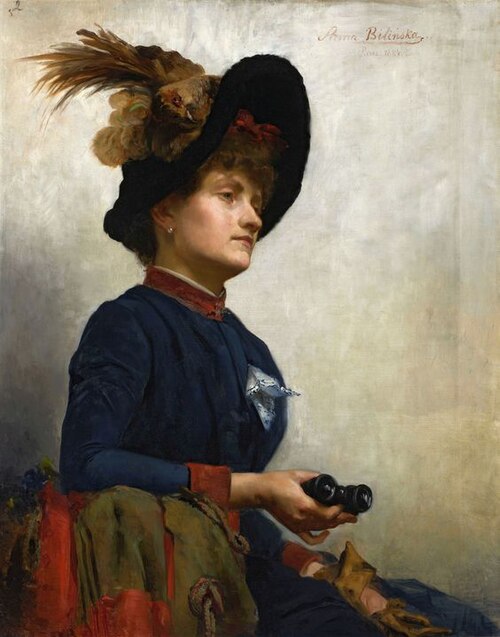
Anna Bilinska-Bohdanovichowa was one of the first Polish painters to achieve international success. Her "Portrait of a Lady", located in the collection of the National Museum in Warsaw, is an example of extraordinary sensitivity and artistic mastery.
The painting depicts an elegant woman in a black dress, sitting against a dark, neutral background. The composition is seemingly simple, but extremely evocative - all attention is focused on the the model's face and her look. You can see the seriousness, pride and a certain mysteriousness that give the work its psychological depth.
Bilinskaya was famous for her ability to capture the individuality of the portrayed person, avoiding schemes and idealization. Instead of creating only decorative images, she tried to reflect the true character of her models. Thus, in "Portrait of a Lady" we see not only external beauty, but also inner strength and personality the woman depicted.
This work is among the artist's most important works and is one of the jewels of the Warsaw museum's collection. It is a portrait that shows that painting can not only be an art of rendering likeness, but also a a window into the soul of man.
"Death of Barbara Radziwillowna" - Joseph Simmler
🎢 Weekend with kids in the capital?
👉 Top 10 - attractions for children in Warsaw
✔️ Official website of the painting
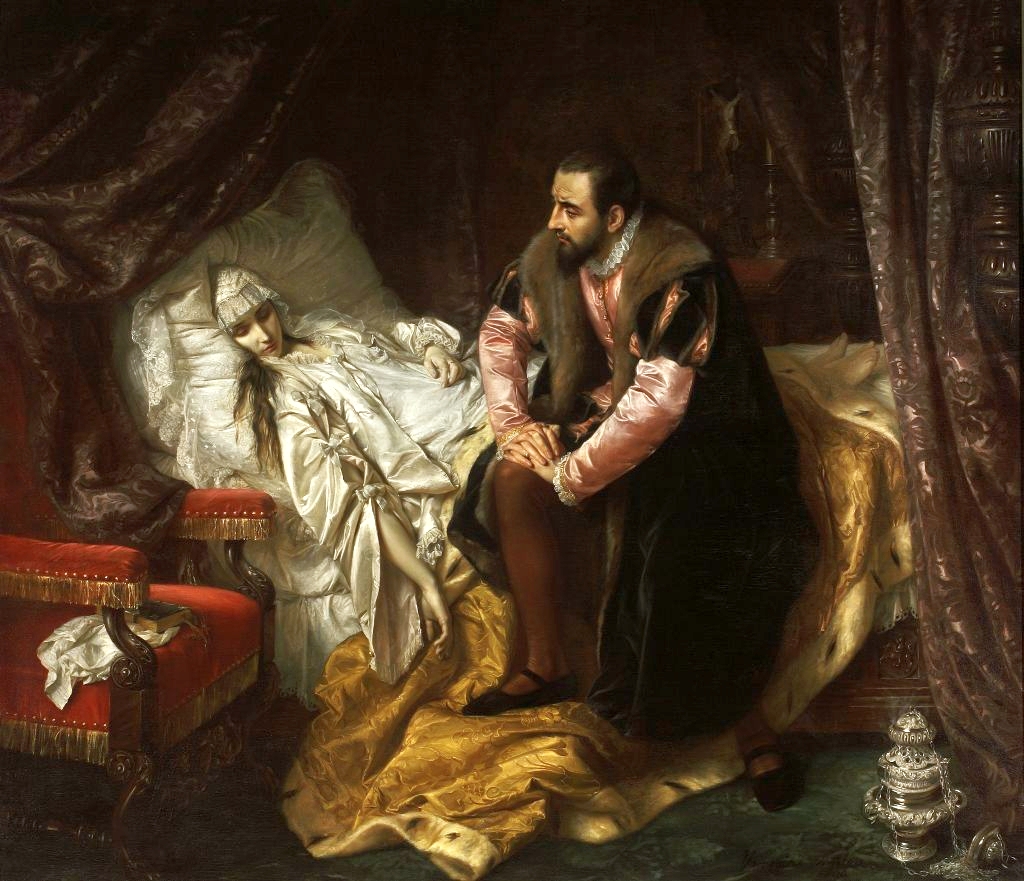
This is one of the most moving works of Polish painting of the 19th century, painted by Jozef Simmler in 1860. The painting depicts Barbara Radziwill's last moments, the beloved wife of King Sigismund Augustus, who died young from illness.
The canvas shows the queen lying on her deathbed, surrounded by a soft light that emphasizes her pallor and fragility. At the foot of the bed kneels Sigismund Augustus, plunged into despair, holding the hand of his dying wife. Next to him stand the figures of the court, whose faces are painted with sadness and helplessness.
Simmler, known for his mastery of rendering emotions, has created a work of extraordinary power of expression. It is a painting not only about love and suffering, but also about human frailty and the inevitability of death. Subtle colors and realistic details give the scene an intimacy that makes the viewer feel as if he or she is participating in the dramatic moment.
"Death of Barbara Radziwill" has moved successive generations of viewers for years. It is an example of painting that combines history, emotion and beauty, making the image memorable for a long time.
"View of Warsaw from the terrace of the Royal Castle". - Bernardo Bellotto (Canaletto)
✔️ Official website of the painting
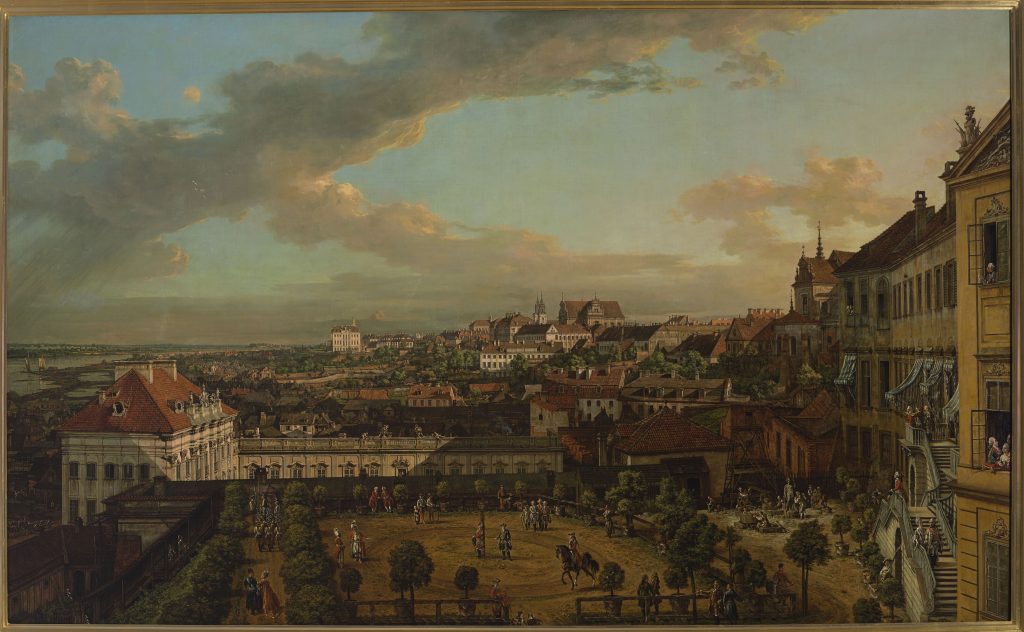
Bernardo Bellotto, known as Canaletto, was a court painter to King Stanislaw August Poniatowski and one of the most prominent creators of vedutas - panoramas of cities. His "View of Warsaw from the Terrace of the Royal Castle" is not only a work of art, but also a priceless historical document, which allows us to see what the capital looked like in the 18th century.
The painting shows Warsaw as seen from the perspective of the royal castle - the city's vast landscape, the Vistula River, bridges and landmark buildings can be seen here. Bellotto was famous for his extraordinary precision, which is why his works have even served for centuries as a source at the reconstruction of Warsaw after World War II.
"The view of Warsaw from the terrace of the Royal Castle" impresses. attention to detail, light and space, which give the scene a realistic yet picturesque character. Looking at the canvas, we have the impression of standing on a castle terrace and observing the bustling city of more than two centuries ago.
Today it is one of the most important works in the National Museum in Warsaw, combining the The beauty of art and the value of historical testimony.
"Madonna with the Child, St. John the Baptist and an angel" - Sandro Botticelli
✔️ Official website of the painting
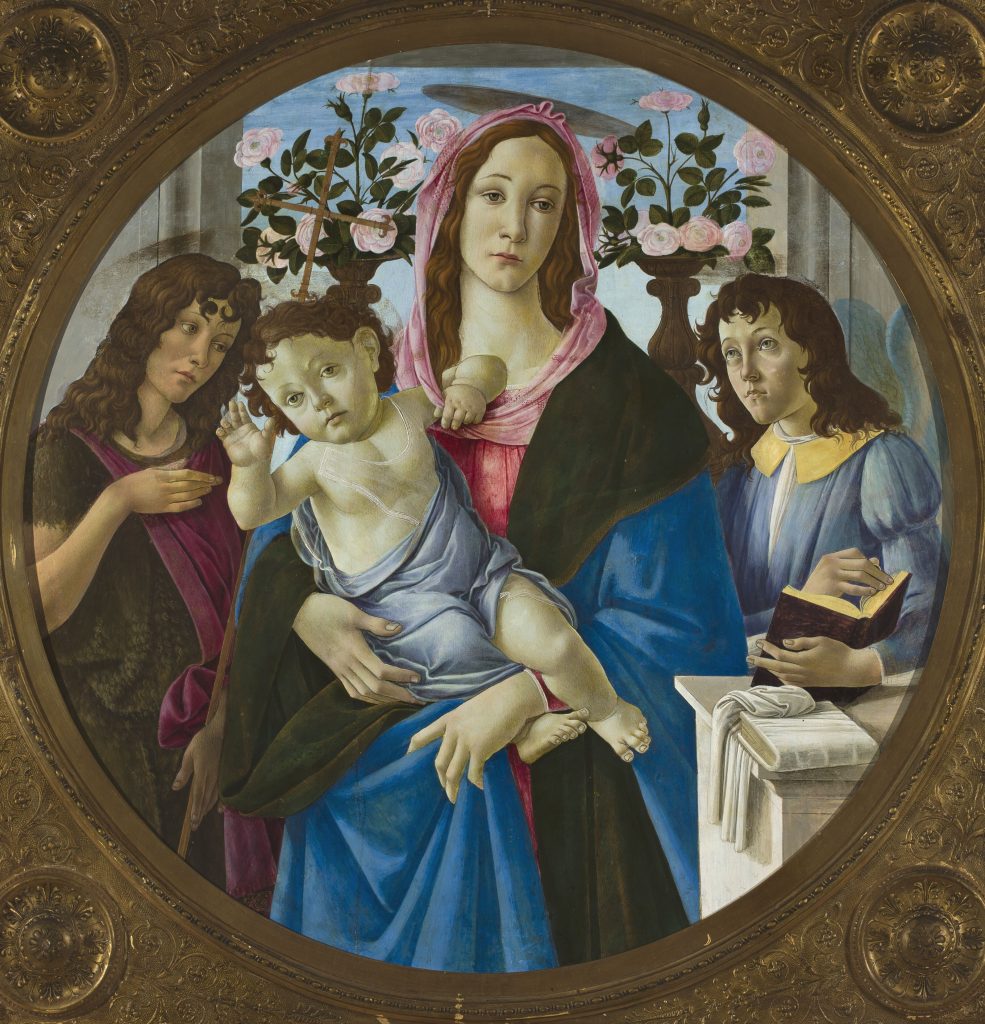
This is one of the most valuable works of Italian Renaissance art in the National Museum in Warsaw. Sandro Botticelli, a master associated with Florence and the Medici circle, painted this picture at the end of the 15th century.
On the canvas we see Mary with baby Jesus, accompanied by a small St. John the Baptist As well as an angel. The composition is harmonious and full of subtlety, and the faces of the figures exude calmness and warmth. Typical of Botticelli are delicate lines, soft modeling and gestural elegance, which give the work a timeless lightness.
This is not only a religious performance, but also an example of the ideal renaissance beauty, in which the sacred is combined with a humanistic view of man. In Botticelli's painting it is easy to see his extraordinary ability to combine spirituality with poetic mood.
"Madonna with Child, St. John the Baptist and Angel" is a true gem of the Warsaw collection - a work that takes the viewer into the world of the Italian quattrocento and allows one to commune with the The mastery of one of the greatest artists in the history of art.
"Battle of Orsha" - painter from the circle of Lukas Cranach the Elder
✔️ Official website of the painting
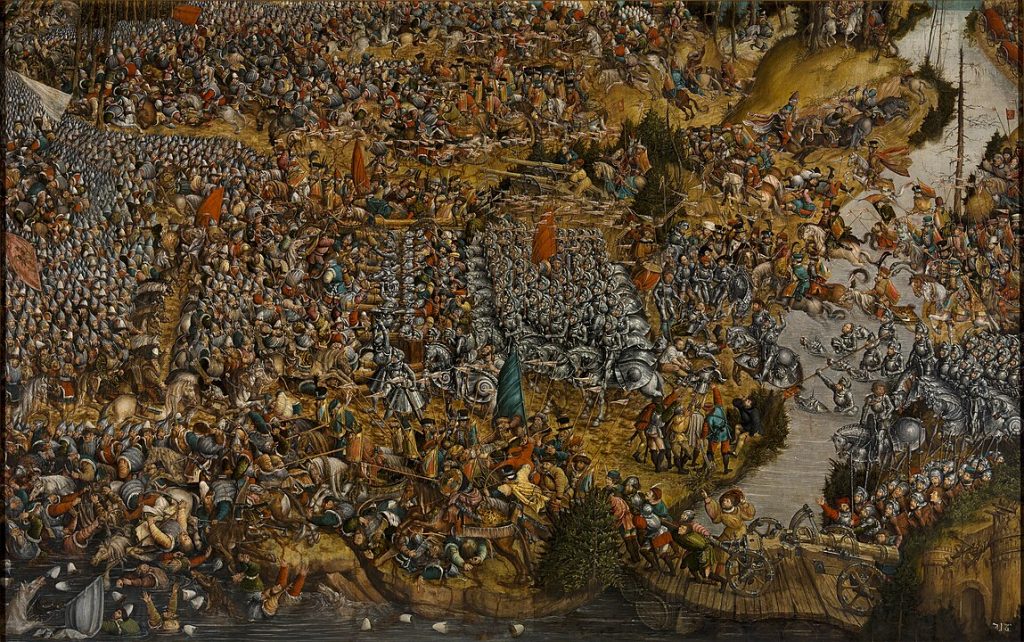
This remarkable work was created around 1524 and is one of the greatest treasures of the medieval-renaissance collection of the National Museum in Warsaw. The painting depicts the battle of Orsha in 1514, in which the Polish-Lithuanian army defeated the more numerous Moscow army.
The canvas impresses with its grandeur and richness of detail - the artist showed on it Hundreds of figures, horses, banners and armaments, creating a true panorama of the battlefield. Thanks to extreme precision, we can see even small elements, such as coats of arms on shields or soldiers' outfits.
"The Battle of Orsha" is not only a testimony to a military triumph, but also to a a unique historical document. This is one of the few depictions of a battle of this period in European painting, and a work full of drama and energy.
The painting has been a source of admiration for centuries - its author remains anonymous, but it is attributed to the the workshop of Lukas Cranach the Elder. Today, it is one of the most fascinating canvases in the National Museum in Warsaw, which allows you to immerse yourself in the atmosphere of the 16th century war and see history through the eyes of the artist.
"Strange Garden" - Jozef Mehoffer
✔️ Official website of the painting
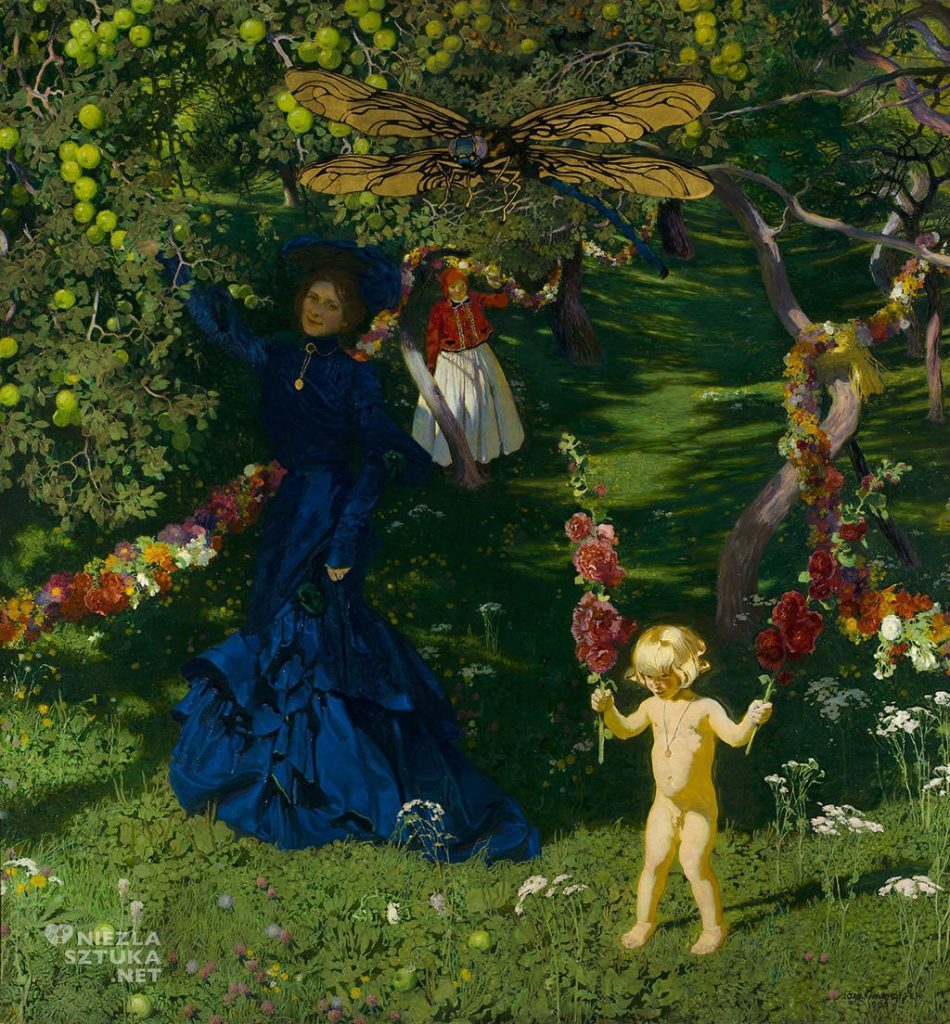
This is one of the most unusual and mysterious works of Polish Modernism, painted by Jozef Mehoffer in 1903. The painting depicts an idyllic scene -. A garden full of flowers, where the artist's wife walks with her several-year-old son. At first glance, the composition seems idyllic, but among the flowers we notice something surprising: giant praying mantis hovering over the figures.
This contrast between the beauty of nature and its menacing, disturbing face gives the work depth and symbolic meaning. Mehoffer brilliantly combined realism of everyday life with an atmosphere of fairy tale and mystery, creating an image that has fascinated audiences for more than a century.
"Strange Garden" is considered to be the manifesto of symbolism in polish painting. It is a work with multi-layered meaning - it can be read as a story about family harmony, about the power of nature, but also about its unpredictable and disturbing nature.
The painting is one of the most admired exhibits at the National Museum in Warsaw. It stops viewers for a long time - because everyone, looking at "Strange Garden," sees something different in it: beauty, tranquility, but also the hidden shadow of mystery.
"Murzynka" - Anna Bilinska-Bohdanovichova
✔️ Official website of the painting
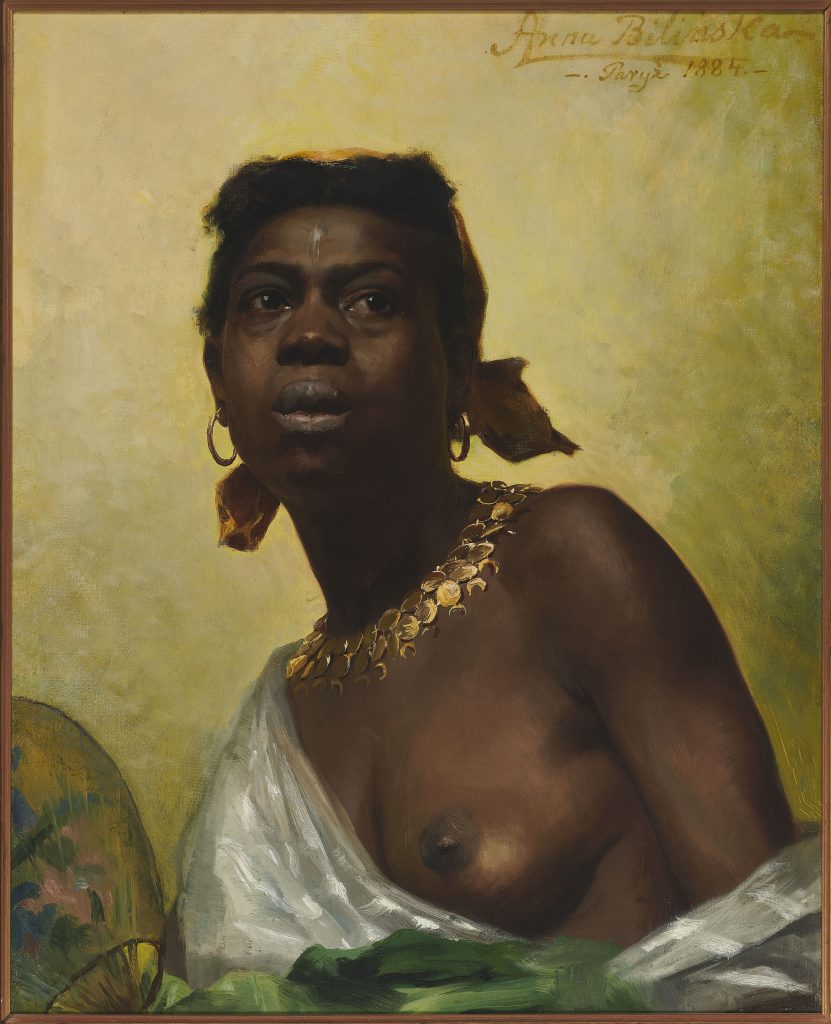
This is one of the best-known works by Anna Bilinskaya, a Polish painter who also gained recognition in the Parisian art scene of the 19th century. The painting was created in 1884 and depicts a young woman with a dark complexion, dressed in white fabric, sitting against a neutral dark background.
The composition is simple, but extremely expressive. The attention is mainly attracted by the face and look of the model - Full of solemnity, dignity and subtle melancholy. The contrast between the light drapery and the dark skin tone of the figure emphasizes the strength of the portrait and gives it a monumental character.
"The Negro Woman" is a work that went beyond the schemes of the time. Bilinskaya, as a woman artist in the 19th century, was breaking barriers herself, and her choice of an atypical model further emphasized her independence and creative courage.
The painting has become one of the symbols of the painter's oeuvre and is still a source of admiration at the National Museum in Warsaw. It is a portrait that delights with its simplicity, and at the same time makes you reflect on the The beauty of diversity and the power of female presence in art.
"Guitarist" - Jean-Baptiste Greuze
✔️ Official website of the painting
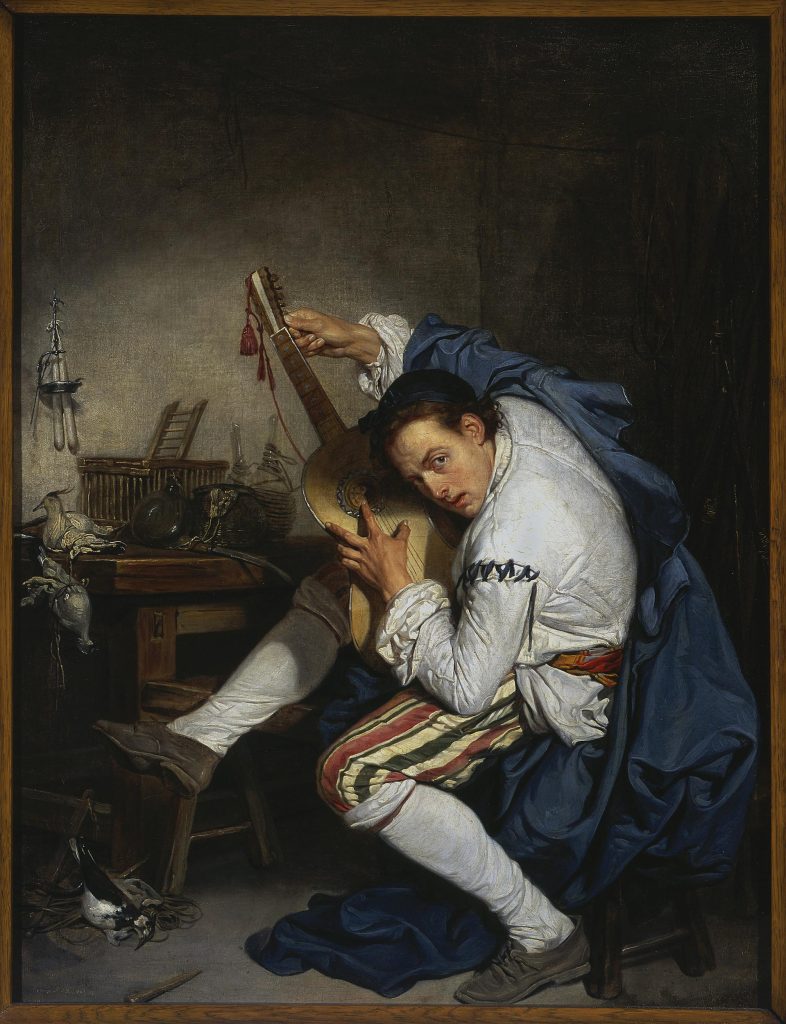
Jean-Baptiste Greuze was a French painter of the 18th century, known for his portraits and genre scenes full of emotion and subtle details. His painting "Guitarist" is a unique work in the collection of the National Museum in Warsaw, combining the charm of music and elegance of the rococo era.
The canvas shows a young man playing the guitar. Dressed in opulent attire, with a gentle smile and light hand movements, the artist has captured him as the music seems to float in the air. Light falling on the face and instrument lends intimacy and lightness to the scene, while highlighting Greuze's painterly artistry.
The painting delights with realism and softness of brushstrokes, making it seem almost alive. This work is not only about the beauty of music, but also about the joy of the moment and the charm of everyday life captured in artistic form.
"Guitarist" is among the most valuable foreign paintings in the National Museum's collection. It is an example of the fact that the Warsaw gallery not only collects Polish masterpieces, but also allows you to commune with the work of the most outstanding European artists.
"Antibes - Morning" - Paul Signac
✔️ Official website of the painting
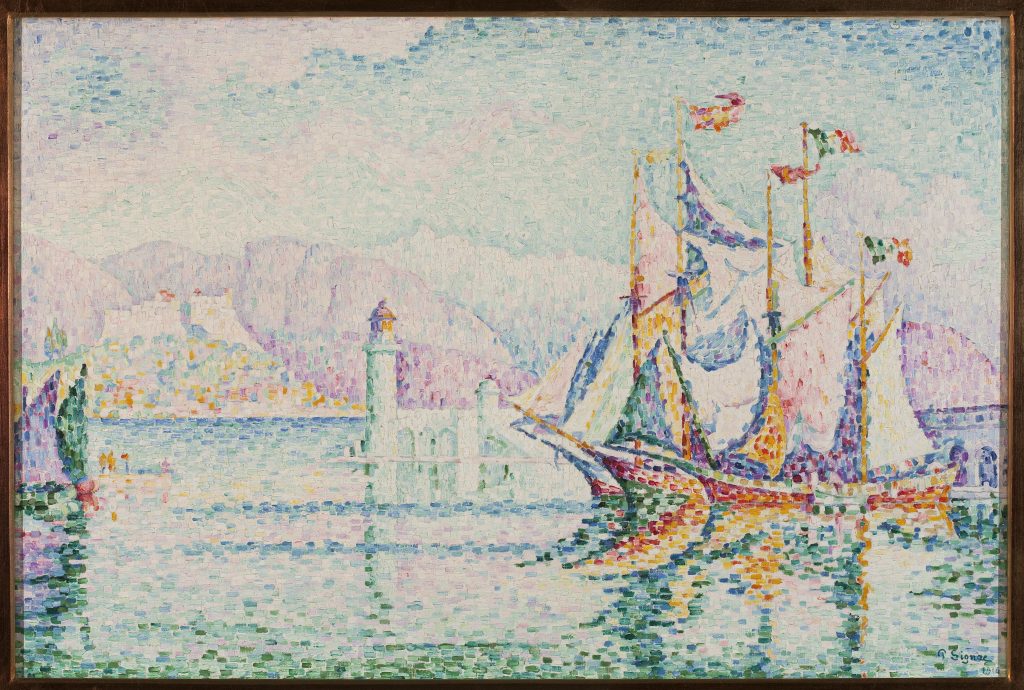
Paul Signac, French master of Neo-Impressionism and co-inventor of the technique pointillism, left behind works that delight with their extraordinary play of light and color. One of them is "Antibes - Morning". dated 1908, belonging to the collection of the National Museum in Warsaw.
The painting shows the French town of Antibes, bathed in the morning sunshine. Signac built the composition from hundreds of tiny specks of color, which from a distance form a harmonious whole, and up close resemble a mosaic shimmering with energy. This makes the landscape seem to vibrate and pulsate with life.
"Antibes - Morning" is an example of art that not only depicts the place, but also captures the atmosphere of the moment - The freshness of the morning, the warmth of the Mediterranean climate and the joy of communing with nature.
Signac's painting at the National Museum is a true pearl of European painting, which allows Polish viewers to encounter one of the most important art directions of the turn of the 20th century. It is a work of art that delights lightness, harmony and luminous beauty.
"Seasons. July-August (Procession III - with a cow)" - Zofia Stryjeńska
✔️ Official website of the painting
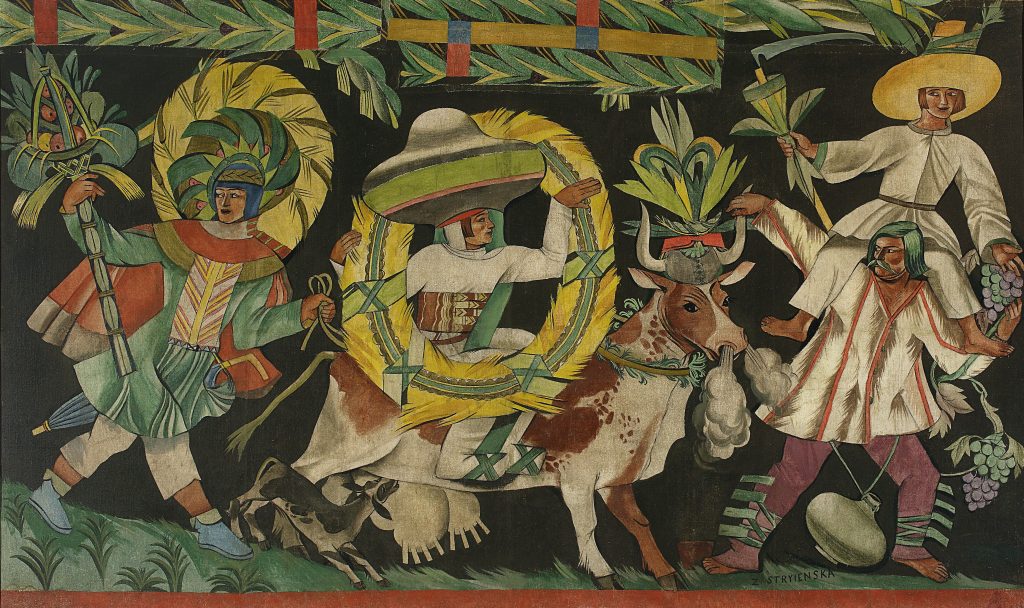
Zofia Stryjeńska, called not without reason "princess of Polish painting", was famous for her colorful, decorative compositions inspired by Polish folklore, traditions and ceremonies. Her series of "Seasons of the Year" is one of his most famous projects, and the painting "July-August (Procession III - with a cow)" is one of his most beautiful pieces.
On the canvas we see Dancing procession of village youths, whose rhythm is accompanied by the presence of a cow - a symbol of abundance, prosperity and man's connection with nature. The whole emanates energies - Intense colors, dynamic movements of the figures and lively composition capture the atmosphere of joy and celebration.
Stryjeńska's style is easy to recognize: fluid lines, strong colors and ornamentation make her works look almost like stills from a fairy tale or illustrated legend. It was this aesthetic that made her art so close to the general public and still impresses with its freshness today.
"Seasons. July-August" at the National Museum in Warsaw is a painting that reminds us of the the beauty of tradition and the strength of Polish folk culture, while at the same time introducing the viewer to the vibrant, colorful world of the artist.
Completion - the greatest treasures of painting in one place
The National Museum in Warsaw is the place where centuries of history, tradition and art meet. In its halls you can admire works of art that have forever made their mark in the history of Polish and world culture - from the monumental compositions of Jan Matejko, through the emotional scenes of Aleksander Gierymski, to the luminous landscapes of Paul Signac and the colorful visions of Zofia Stryjeńska.
Each image we mentioned is a a story encapsulated in colors and lines - about victories and defeats, everyday life and dreams, the beauty of nature and the power of imagination. Visiting the museum, you can not only see masterpieces, but also feel the emotions of their creators and heroes.
A visit to the National Museum in Warsaw is a journey through time and space - from Renaissance Italy, through 19th-century Warsaw, to the modernist experiments of the 20th century. This is one of those places worth returning to, because it Each time you discover something new about it.

